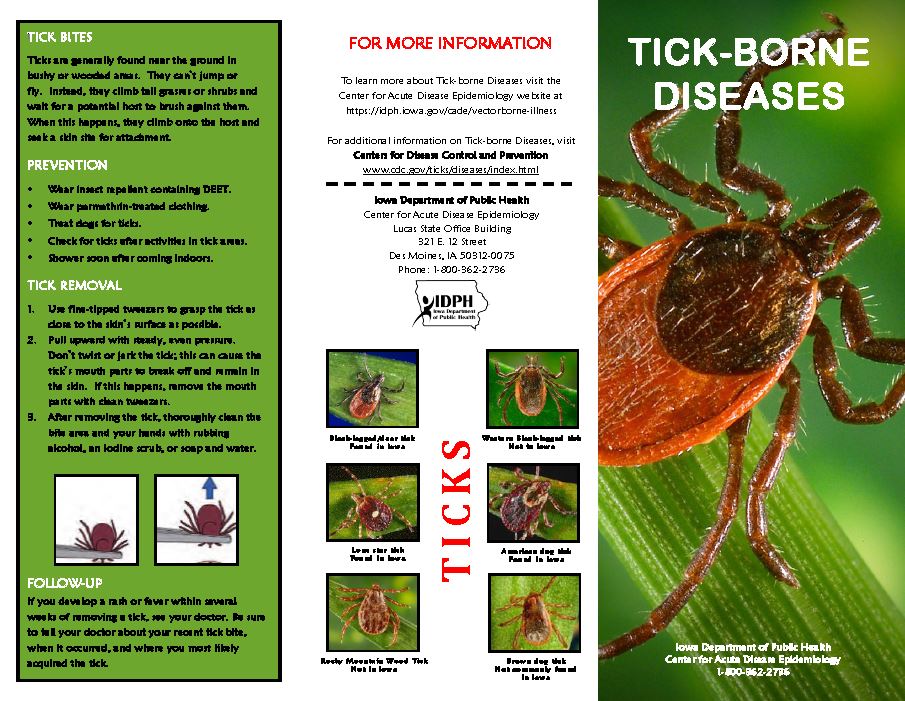Rocky Mountain Spotted Fever (RMSF)
Definition
Rocky Mountain Spotted Fever (RMSF) is a disease caused by the bacterium Rickettsia rickettsii. It causes fever, nausea, muscle ache, headache and a rash. It can lead to loss of blood cells (anemia) and other serious blood disorders. It is most common from April through September when people are exposed to ticks outdoors. Most cases occur in children under age 15 since they tend to spend more time in tick-infested areas.
RMSF is reportable to the Iowa Department of Public Health by Iowa Administrative Code 641 IAC 1.
Symptoms
It will take about one week after being infected with RMSF to start to show signs and symptoms. Early symptoms can include:
- Fever/chills
- Nausea/vomiting
- Muscle ache
- Feeling poorly
- Headache
- Swelling in eye
As the disease progresses symptoms include:
- Rash (3-5 days after start of illness)
- Stomach and joint pain
- Diarrhea
Complications from RMSF may include:
- Decrease in red blood count (anemia) and other blood disorders
- Long term nerve damage
- Death
Causes
Rocky Mountain Spotted Fever is caused by a tick bite. Usually a tick has to be attached to a person for four to six hours for infection to occur. Less often, infection occurs when crushed tick tissues or fluids get into a person’s cuts or scratches.
Risk Factors
People, especially children, who are outside in places where ticks are common are most at risk. The months of April to September are the most common times to be infected.
Prevention
- The best way to avoid RMSF is to avoid tick-infested areas such as woody and grassy areas.
- In areas where ticks may occur, people should: Wear long-sleeved shirts and long, light-colored pants tucked into socks or boots to make it easier to see ticks crawling on clothing, and to prevent ticks from crawling up the inside of pants legs.
- Stay on trails when hiking
- Use insect repellants properly. Repellants that contain DEET (diethyltoluamide) should be used in concentrations no higher than 30 percent for children. Repellants should never be used on infants. Permethrin is a repellant that can be applied only to clothing, not exposed skin.
- After each day spent in a tick-infested area, thoroughly check yourself, children, and pets for ticks. Remove any tick you find on your body. Clothing should also be checked.
- Promptly remove any attached tick using fine-point tweezers. The tick should not be squeezed or twisted, but grasped close to the skin and pulled straight out with steady pressure. Once removed, the tick should be drowned in rubbing alcohol or the toilet.
Treatment
- Appropriate antibiotics can successfully treat Rocky Mountain Spotted Fever.
- Seeking good follow up care from a medical provider is the best way to make sure someone recovers.
Statistics
In 2021, 4 cases of Rocky Mountain spotted fever (RMSF) were reported in Iowa.
For more detailed information and statistics on all notifiable diseases, please see our current annual report located in the reports section of the CADE homepage.
Additional Resources
Educational Materials
A tick-borne disease brochure can be ordered by completing this form.
Download a pdf of this brochure. 
